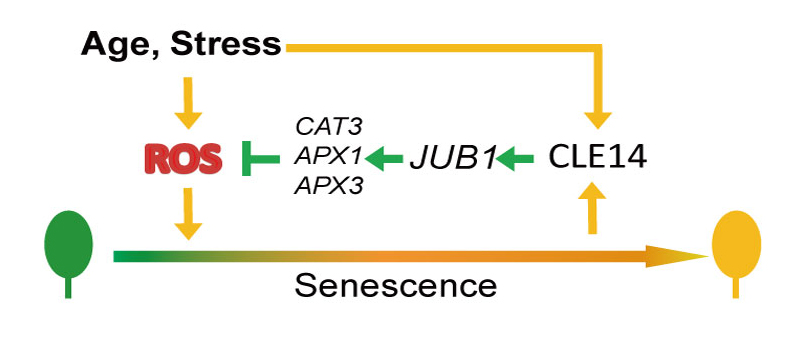博文
Molecular Plant:小肽CLE14通过ROS清除来延缓拟南芥的叶片衰老
||
CLE14 functions as a “brake signal” suppressing age-dependent and stress-induced leaf senescence through promoting JUB1-mediated ROS scavenge in Arabidopsis
第一作者:Zenglin Zhang
第一单位:中国农科院烟草所
第一通讯:Yongfeng Guo
Abstract
背景回顾:Leaf senescence is an important developmental process in plants’ life cycle and has a significant impact on agriculture. As an adaptive mechanism, when facing harsh environmental conditions, monocarpic plants often initiate leaf senescence early to ensure a complete life cycle. Upon initiation, the senescence process is fine-tuned through the coordination of both positive and negative regulators. 主要发现:Here we report a small secreted peptide, CLAVATA3/ESR-RELATED (CLE) 14, which functions in suppressing leaf senescence through regulating ROS homeostasis in Arabidopsis. 结果1-CLE14在叶片中的诱导表达模式:Expression of the CLE14-encoding gene in leaves was significantly induced by age, high salinity, abscisic acid (ABA), salicylic acid (SA) and jasmonic acid (JA). 结果2-CLE14敲除与过表达或外施处理表型:CLE14 knock-out plants displayed accelerated progression of both natural and salinity-induced leaf senescence. On the other hand, increased CLE14 expression or treatments with synthetic CLE14 peptides delayed senescence. CLE14 peptide treatments also caused delay in ABA-induced senescence in detached leaves. 结果3-CLE14与ROS:Further analysis showed that CLE14 gain-of-function led to reduced ROS levels in leaves, where higher expression of ROS scavenging genes were detected. 结果4-CLE14-JUB1-ROS清除:Moreover, CLE14 signaling resulted in transcriptional activation of JUB1, a NAC family transcription factor previously identified as a negative regulator of senescence. 结果5-CLE14-JUB1-ROS清除-延缓衰老:Notably, the function of CLE14 peptides was JUB1-dependent in delaying leaf senescence, reducing H2O2 level, and activating ROS scavenging genes. 结论:We propose that small peptide CLE14 serves as a novel “brake signal” in regulating age-dependent and stress-induced leaf senescence through JUB1-mediated ROS scavenging. 摘 要 
叶片衰老是植物生命周期中一个重要的发育进程,对于农业来说具有非常重要的影响。作为一种适应机制,当面临恶劣的环境条件时,一次结实的植物通常会提前开始叶片衰老,以确保生命周期的完整。一旦开始,衰老就会由正向和负向调控因子的协同作用精细调节。本文中,作者报道了拟南芥中一个小的分泌多肽CLE14通过调控活性氧物质ROS的内稳态,抑制叶片的衰老。叶片中CLE14基因的表达受到年龄、高盐、脱落酸、水杨酸和茉莉酸的显著诱导。CLE14敲除株系的叶片自然衰老和盐诱导的衰老进程明显加快。换句话说,CLE14表达量的增加或是合成CLE14多肽的处理会延迟叶片衰老。CLE14多肽的处理还会延迟离体叶片由ABA诱导的叶片衰老。进一步的分析发现CLE14功能获得的植株叶片ROS水平明显降低,其中ROS清除基因的表达明显增强。此外,CLE14信号转导会激活一个NAC转录因子JUB1的转录激活,该基因是衰老的一个负调控因子。有趣的是,CLE14多肽在延迟叶片发育、降低过氧化氢水平以及激活ROS清除基因等方面的功能依赖于JUB1。因此,作者认为小肽CLE14作为一个新的“刹车信号”,通过JUB1介导的ROS清除来调控年龄依赖性和胁迫诱导的叶片衰老。
通讯作者
** 郭永峰 **
个人简介: 2006年,康奈尔大学,博士。 研究方向: 1)叶片衰老的分子生物学; 2)植物多肽信号对发育过程调控的分子机制; 3)烟草等特种作物重要农艺性状调控基因的克隆及功能研究。
doi: https://doi.org/10.1016/j.molp.2021.09.006
Journal: Molecular Plant
Published date: September 13, 2021
https://blog.sciencenet.cn/blog-3158122-1304264.html
上一篇:the plant journal:番茄磷饥饿下DNA甲基化动态及其与基因表达和可变剪切之间的关联
下一篇:Nature Communications:427份毛竹全基因组重测序揭示其群体结构和重要性状的遗传基础
全部作者的其他最新博文
- • Plant Physiology:CsMADS3促进柑果中的叶绿素降解和类胡萝卜素合成(华中农业大学)
- • Molecular Plant:LBD11-ROS反馈调节作用于拟南芥的维管形成层增殖和次生生长(浦项科技大学)
- • Science Advances:根结线虫通过调控植物的CLE3-CLV1模块,促进侵染进程(日本熊本大学)
- • Nature Communications:油菜素内酯参与植物营养生长期转变的分子机制解析(浙江农林大学)
- • Current Biology:光合作用产生的蔗糖驱动侧根“生物钟”(德国弗莱堡大学)
- • PNAS:花同源异型基因在叶中被抑制、花中被激活的分子机制(南卡罗来纳大学)